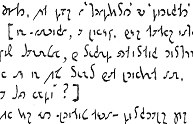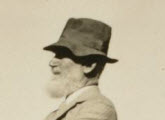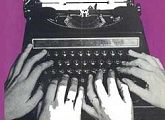Love letters
Manuscripts, calligraphy, palaeography
 |
| |
|
A large proportion of the collections described on the Archives Hub consists of manuscripts. We perhaps tend to think of a manuscript as something very old and valuable, but a manuscript is simply a handwritten document, and these can take many forms. Manuscripts may include letters and diaries. And most manuscripts just involve pen and paper. Manuscripts may be written in fine writing or calligraphy, and they may be written in other forms of handwriting and scripts, whether for other languages or for special purposes, such as mathematical or musical notation, and shorthand. The way we write changes with time and with changes of culture, so even documents handwritten in English just a few centuries ago might require palaeography specialists in order to be read today, but with the right skills it is still possible to decipher manuscripts such as papyri from ancient Egypt, written thousands of years ago.
Collections
- Joseph Gillott (1799-1872): Birmingham pen manufacturer and patron of the arts
- De La Rue Company: London designers and manufacturers of diaries and fountain pens.
- Marion Richardson (1892-1946): influential art teacher and pioneer of the child art movement; developed a system for teaching handwriting.
- Gertrude Bell (1868-1926): includes letters between Gertrude Bell and Charles Doughty-Wylie (1868-1915), an army officer killed in action at Gallipoli
- Somerville and Ross: writers Edith Somerville (1858-1949) and Violet Martin (1862-1915) both kept detailed diaries
- Jane Franklin (1792-1875): traveller and social reformer; her extensive journals and diaries relate the search for the missing British Naval Northwest passage Expedition, 1845-1848 led by her husband Sir John Franklin
- Commonplace book: a personal miscellany of manuscript notes, 1824, creator not known.
- Herbert Mayo Leman (fl 1950): Nottingham solicitor; collector of musicians' autographs
- Johannes de Sacro Bosco (fl. 1230): mathematician and astronomer; these manuscripts are part palimpsest (with later writing superimposed) with traces of erased text still visible
- Three German devotional works: 17th-18th century, in calligraphic script, with pen-and-ink decorative head and tail pieces
- Price family of Menai Bridge, Anglesey; some of the family 'commonplaces' (scrapbooks) are written in formal 'copperplate' hand
- Anthony Grey (born 1938): compiled over 300 crosswords while held hostage in Peking, 1967-1969
- W. Y. Evans-Wentz (1878-1965): anthropologist and linguist; collected palm-leaf manuscripts
- Coptic manuscripts: includes papyri found by Egyptologist Sir Flinders Petrie (1853-1942).
- Arthur Jefferies Collins (1893-1976): palaeographer; Keeper of the Manuscripts at the British Museum.
- Julian Brown (1923-1987): scholar of medieval manuscripts and palaeography.
- Gabriel Neil (fl.1830s): archaeologist and antiquarian in Glasgow, with an interest in deciphering ancient manuscripts.
- Donald Auberon Bullough (1928-2002): Professor of Medieval History, with an interest in palaeography.
- William Carlton (1886-1973): collector of all things concerning the history of shorthand
- James Hervey (1714-1758): some of the manuscript drafts of Hervey's religious works are written in an undeciphered shorthand.
- Douglas Rayner Hartree (1897-1958): mathematical physicist; this collection includes four folders of handwritten calculations.
- Alan Rawsthorne (1905-1971): composer; this collection includes manuscripts for unpublished compositions.
Related links
- Society of Scribes and Illuminators: professional society founded in 1921.
- Edward Johnson Foundation: research centre for calligraphy
- Palaeography tutorial (The National Archives)
- Palaeography (National Archives of Scotland)
- Modern Calligraphy Collection (Victoria and Albert Museum, London)
- Black Book of Carmarthen (Digital Library of Wales)
- Vindolanda: writing tablets excavated from the Roman fort at Vindolanda in northern England
- Palaeography & Manuscript Studies (University of London Library)
- Ancient book of psalms discovered (National Museum of Ireland, Dublin)
- Pen Room: Birmingham Pen Trade Museum (Hockley, Birmingham)
- Cumberland Pencil Museum (Keswick, Cumbria) [website requires the free Flash media player]
- British Postal Museum & Archive (London)
Further reading
Links are provided to records on Copac for these items. Copac is the free, web based national union catalogue, containing the holdings of many of the major university and National Libraries in UK and Ireland plus a number of special libraries. For more information about accessing items see the FAQs on the Copac website.
- Julian T. Brown A palaeographer's view - the selected writings of Julian Brown, edited by Janet Bately et al (1993) Records on Copac
- Steven R. Fischer A history of reading (London : Reaktion, 2003) [a history of writing] Records on Copac
- Henri-Jean Martin The history and power of writing (Chicago ; London : University of Chicago Press, 1994) Records on Copac
- Walter M. Miller, Jr. A canticle for Leibowitz (London : Orbit, 1993) [originally published 1960] Records on Copac
- Alberto Manguel A history of reading (London : Flamingo, 1997) Records on Copac
- Walter J. Ong Orality and literacy : the technologizing of the word (London ; New York : Methuen, 1982) Records on Copac
P.S.
The words 'Read' and 'read', 'reading' and 'Reading' are homographs (same spelling, different meanings), and perhaps the surname Read here also presents an example of nominative determinism.
You can receive regular updates on our special features by joining our mailing list.





